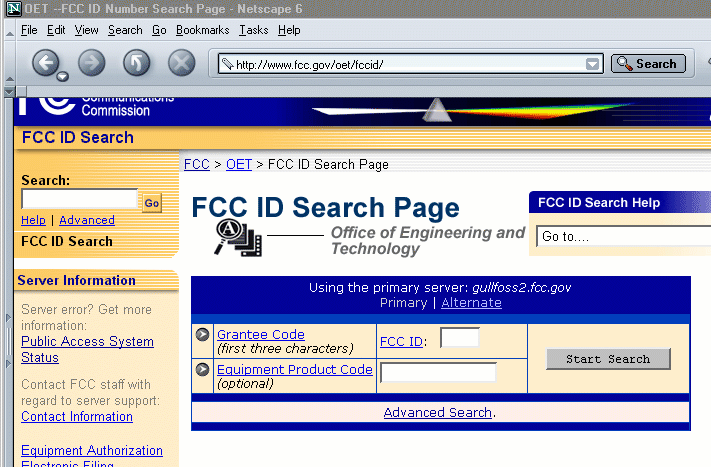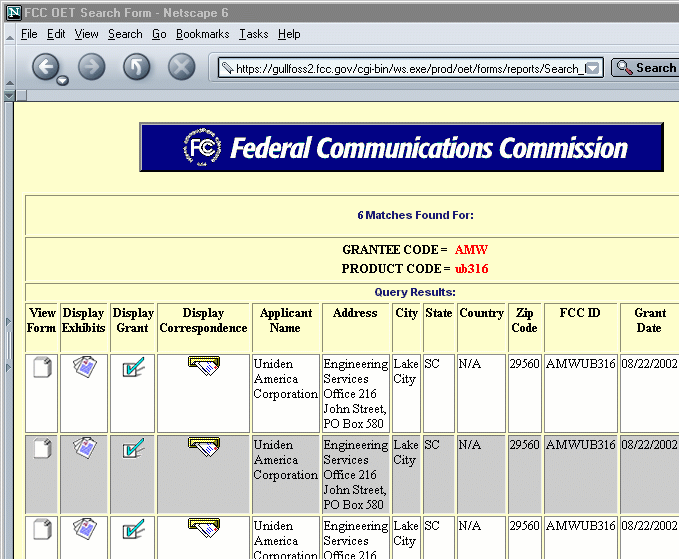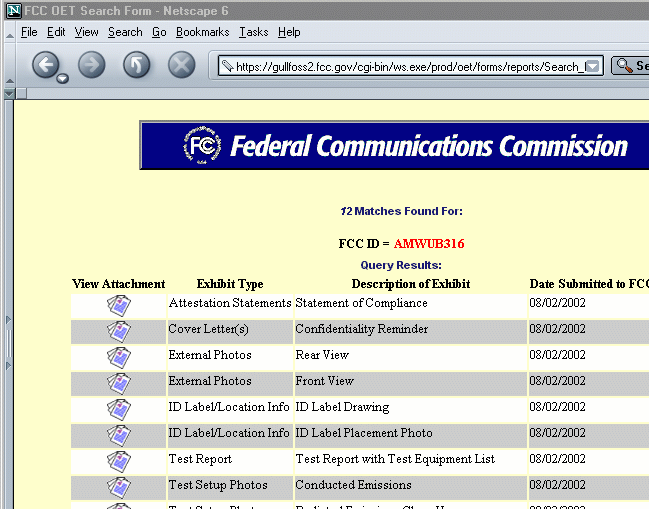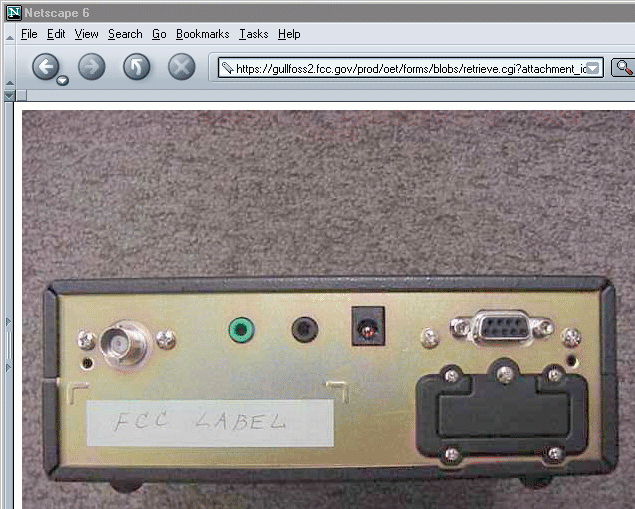| This article first appeared in the October 2002 issue of Monitoring Times. |
Autumn is here and it's time to cover some letters that have come in the mailbag. We have some Missouri frequencies, several recommendations on computer control software and antennas, and we round up with a quick tutorial on getting type acceptance equipment information from the Federal Communications Commission (FCC) website.
Green County/Springfield, Missouri
Hello Dan,My name is Gary and I am a subscriber from Springfield, Missouri. Here in the Greene County, Springfield, Missouri area, we are in the final stages of installation of a new 800 MHz trunking communication system for all public service agencies. I would like to ascertain if you have, have heard about, or can obtain any information regarding this new trunking system. I have the frequencies they are to operate on, but I don't have any information about groupings etc. Some of the agencies are simulcasting on the new trunking and the old UHF system. Any assistance and/or information you have would be appreciated.
Thanks much, Gary.
The Greene County Sheriff's Department historically as used a couple of frequencies in the VHF band, namely 155.145 and 155.730 MHz. The Springfield Police Department has several frequencies in VHF and UHF: 154.860, 154.890, 154.490, 458.800, 458.850, 460.020, 460.100, 460.225, 465.400, 465.500, 465.025, 465.100 and 465.225 MHz. The Springfield Fire Department uses 458.250, 458.600, 458.950 and 458.6250 MHz.
It's not clear how long these frequencies will remain in use, since the new trunked radio system is currently being brought on-line for the county sheriff and highway department as well as the Springfield police, fire and public works. Another seven agencies and a dozen fire departments are expected to join the system in the near future.
The new Motorola Type II system is configured to support both analog and digital radios, with the majority of traffic expected to be analog. Officials claim that digital communications will also be encrypted. The initial radio fleet includes about 120 digital radios and more than 1,600 analog units.
Seven sites will simulcast on eighteen assigned frequencies: 854.9875, 855.4625, 855.7375, 856.2125, 856.4375, 856.7125, 856.9625, 857.2125, 857.4375, 857.7125, 857.9625, 858.2125, 858.4375, 858.7125, 858.9625, 859.2125, 859.4375 and 859.7125 MHz.
Released talkgroups are as follows:
Decimal Hex Description
848 350 Springfield PD South Side Dispatch
912 390 Springfield PD North Side Dispatch
1648 670 Springfield Fire Dispatch
16592 40D0 Greene County Sheriff Patrol 1
16624 40F0 Greene County Sheriff Patrol 2
16656 4110 Greene County Sheriff Countywide Patrol
17264 4370 Greene County Rural Fire
24592 6010 Republic Fire
24624 6030 Republic Common
24752 6060 Republic PD
Comments on Computer Control
First, a positive report about BlackBag's control programs for Uniden's 780XLT base/mobile scanner and the 245XLT handheld.
Dan,I wanted to take a few moments to tell you that your June article in Monitoring Times encouraged me to go out and find a PC control program for my Uniden BC780XLT scanner. I have owned this fine scanner for several months, and had considered getting a control program for it. Your article spurred me on.
After going to the StrongSignals web site to check out what my options were, I decided on the program from BlackBag Software. I don't know if this is an indication of the overall quality of the company, but I placed my order via their website on Saturday morning, and my order arrived at my house the very next Monday afternoon. Talk about service!
I purchased two software control programs from BlackBag. The 780 control program and the BC245XLT control program. I should note that the 780 control program I purchased was less than half the cost of some of the major programs on the market today, and it even comes with a control cable include in the price. The software loaded right up without any problems, and runs quite well on my Windows XP Pro system, so I presume it will work equally well with earlier versions of Windows, including Windows 2000. I was able to get the program configured in a matter of minutes, and was doing Service Searches and Trunk tracking almost immediately. The user interface is clean and functional and very intuitive.
Also, for the same price of $28.50 ($25 + $3.50 for priority mail), I got BlackBag's Frequency Logger program, which is a nice addition to operating my 780.
If there is a weak point in the package that I bought, it is that no documentation comes with the program. You are prompted to take action through pop-up dialogue boxes, but I can't find a documentation file on the CD or on the company's website. Also, there does not seem to be any help available through the program. Maybe I've missed something, but I've looked several times without success. Though using the program was easy for me, it might not be as easy for someone who is still fairly new to working with Windows.
The website address I went to, to get this program was http://www.bc780xlt.net/. They also carry a Palm OS control version of the program.
That's it. I just wanted to let you know that this program is well worth the money for anyone looking for a good, fairly priced for what you get, control program for their BC780XLT.
Jeff in Denver, Colorado
Also in the mailbag, some positive words about ScanCat Gold SE control software for several radios.
Hello,I just read your column in the August 2002 issue of MT and thought I throw my two cents in.
I've had computer controlled radios and software for sometime now, beginning with the Icom PCR1000 and leading up to the 780XLT. I own the PRO-2052, the 245XLT, the 895 as well as computer-capable amateur gear such as my Icom 706, Kenwood D700A and now my Yaesu VX-7R. I mention all that to reinforce the point of the need to have a computer control program capable of controlling many different types of radios - receivers and transceivers alike. That program is Computer Aided Technology's Scancat Gold SE.
Obviously, the multi-radio capabilities are its number one asset, but with the program's ability to use several different database formats, the logging choices and its trunk tracking ability make the software even more alluring. I can download a database from the several frequency CD-ROMs I own into a DBase format and scan that database with Scancat without any further manipulation required. I can do complete logging of these frequencies not to mention graphical plots of frequency hits vs. time or decibel - there are several possibilities. The software also has a built in spectrum analyzer which works well with all the radios I've controlled with the software. Heck, the software even has a subprogram for changing, copying and editing a wide range of files and databases including it's own SCN and FRQ formats.
I think anyone who has invested in a computer controllable receiver has the right to expect the best in control software especially if there are large databases to be shifted through or a lot of programming. For my money, ScanCat can not be beat.
That's my two cents worth. I look forward to reading your column in the future. Till then, 73.
Mark in Tucson, Arizona
Antennas
I have also received a number of comments regarding various antennas that people are using. Here Brian makes some good points and offers several recommendations.
Hi Dan,In reference your column in the July MT, I have the following comments. Firstly you have to differentiate between base and handheld units. For base stations you can use a rotatable antenna like the Grove Scanner Beam, with good quality coax as a must. In my case I have good success with the Grove Scantenna mounted in my attic.
For handhelds it's a different story. I think it was Bob Grove who said, "You don't need antennas but attenuators." In a lot of cases putting a good antenna on your scanner creates more problems (front-end overload, cross modulation, etc.). I agree that the "rubber duckies" leave a lot to be desired. Personally I use a Watson W-889, but there are similar units available such as the Grove Universal Telescoping Whip and the MFJ 1812. Also good are the MFJ 1710 or the AEA Hot Rod, which you can also use for transmitting on 2 meters.
Thanks, Brian in Seabrook, Texas
Another reader has found a good 800 MHz performer for handhelds.
I agree the Max antennas are great for 800 MHz but are a little difficult to live with on a handheld strapped to your belt. I found a very effective 800 MHz "ducky" on the web at Durham Radio in Canada. I'm very impressed with the reception that their "800 BNC" gives me on our countywide 800 MHz trunked and non-trunked towers. It even performs very well inside the car.Bob in New Philadelphia, Ohio
Uniden Bearcat 785D
In August the Federal Communications Commission (FCC) granted type acceptance to the soon-to-be-released Uniden BC785D, the mobile/base version of their APCO Project 25 scanner.
The FCC's Office of Engineering and Technology (OET) maintains an "FCC ID Number Search" on their website that allows anyone to look up filing information related to a certified or type accepted product. Every FCC identification number, usually found on the back or bottom of a piece of equipment, is made up of two parts. The first part is the Grantee Code, which is made up of three characters assigned by the FCC to a company to identify all of their products. The remainder of the ID number, anywhere from one to 14 characters, is called an Equipment Product Code and is assigned by the company submitting the application.
The 785D has an FCC ID Number of AMWUB316, where AMW is the Grantee Code and UB316 is the Equipment Product Code. We can use this information on the FCC's website to find the filing information Uniden submitted related to this receiver.
Using your favorite web browser go to http://www.fcc.gov/oet/fccid/ and you should see the search form. Put in AMW in the Grantee Code box and UB316 in the Equipment Product Code box, then click on the "Start Search" box.

You should get back six records of information. Click on the first icon under "Display Exhibits" and you'll get a dozen records that Uniden submitted.


You can then click on any icon in the "View Attachment" column. The third selection, for instance, brings up a picture of the rear view of the receiver, showing the connectors and the probable slot for the digital decoder card.

You can look up information on nearly any piece of approved equipment. The FCC ID for the PRO-92 scanner, now on sale at Radio Shack for less than $200, is AAO2000522. My Radio Shack wireless thermometer is AAO6301026R. I've even looked up the filing records for the SpeedPass receivers you see at many of the Mobil gas stations.
That's all for this month. Enjoy the fading days of autumn, if you can, and let me know what you're monitoring via electronic mail at dan@signalharbor.com. My website at http://www.signalharbor.com has updated information and additional links. Until next month, happy monitoring!